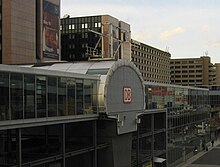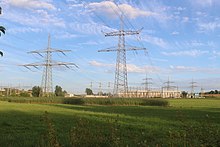Construction work

A preliminary construction work is a component created in advance that is not yet used. This can be done in a project to be implemented in several stages. The basic option of future expandability can also be preserved through preliminary construction work. The early implementation, often only in the shell, can be due to construction technology, finances or use.
Basics
In general, the renovation of civil engineering structures causes a noticeable change in the building fabric. In addition to the costs, use on the construction site is restricted. If potential expansions and additions have already been considered as options in the construction planning, demolition work can be less extensive, the construction site area can be spatially separated from the area of current use, and the overall effort and costs involved in implementing such an option can be considerably reduced. Construction work is known among other things for traffic structures.
In particular, if there is considerable potential for savings compared to the lower costs of the preliminary work, preliminary construction work can be justified even with a low probability of realization or exercise of the options in the future.
Traffic routes
The route control systems , also keep free road , route provision or Vorhaltetrasse called as a reservation of space for a complete traffic route is the task of regional planning . In the case of traffic structures , however, space can be reserved for future extensions. A noise protection wall on a motorway can be offset to the side by the width of an additional lane, bridges can be dimensioned to increase in span, width or load-bearing capacity. Examples are the wide median of the A 45 south of the Gambacher Kreuz junction for an extension from four to six lanes and, on the Antwerp-Brussels motorway , the space left in the median for a super- expressway planned once. The section between Machelen and Mechelen has been used for the 25N railway line since 2012 (part of the Diabolo project ). On the NBS Mannheim-Stuttgart , the tracks are laid north of the Pfingstberg tunnel at a distance of 15 meters; here there is the option of integrating the eastern Riedbahn .
Motorway triangle Würzburg-West with connecting pieces for a connecting lane to the north
Motorway A 45 near Karlstein with space for further lanes in the median
Roundabout with exit into the corn field
Furthermore, the geometric structure of traffic structures can already be designed for extensions. Many motorway triangles are only partially developed motorway junctions . Apart from bridges that may still be missing and earthworks that are already in place, in principle only small additions need to be made. Examples are the triangles prepared as a motorway intersection, Würzburg-West and Seligenstädter Dreieck .
A preliminary construction work that has since been put into operation for the originally intended purpose is the route for the rail link to Athens airport. In contrast, a railway line of the Diabolo project was built in place of the originally planned road on part of the wide median of the Antwerp-Brussels motorway .
Route for rail connection of Athens airport
A1 motorway from Antwerp to Brussels with an extremely wide median
Construction work in civil engineering


In bridges, the design of abutments , foundations and pillars for wider structures or higher loads is known. The extension of bridges while maintaining traffic is possible if the work does not take place at the traffic level. When building a new route on an existing route, a bridge can be built nearby and then lifted or pushed in. Construction work can take place in the form of a complete structure, which is initially only partially driven.
Tunnels have to be built on site; their construction has a significant impact on the geology and statics of the adjacent areas. Construction work can take various forms. No foundation foundations in the area and no buildings above the tunnel route can be provided. In the case of high-rise structures constructed in advance, particularly deep foundations are still stable during tunnel construction, while force-dissipating foundations reduce the load in the future tunnel cross-section.
It is also possible to design underground structures as bridges. When creating multi-storey civil engineering, creating tunnel sections avoids a later undertaking of the building complex. In the case of a tunnel, the connection of another tube or the addition of a junction with a previously built tunnel connection is significantly cheaper and basically possible without interrupting traffic.
Construction work on the station section on the lowest floor below Hanover Central Station
Tunnel connection of the Waterloo underground station in Hanover
Prepared branch at Potsdamer Platz S-Bahn station
Additional tubes never in operation at the Hauptbahnhof Nord underground station in Hamburg
A generic example is the construction of ramp structures between the subway line and the surface as a rectangular box with a flat bottom. The ramp, which is heaped up with gravel, only needs to be dredged if it is extended. At the Lötschbergbahn , tunnels were partly laid out completely with two tracks, partly only the vault was planned for two tracks, but the stope was only cleared for one track. In the Lötschberg base tunnel , tunnel tubes and tunnel nozzles have already been built for the optional complete expansion to two tracks.
Overhead lines
Construction work can also be performed for the construction of overhead lines. This is particularly useful in areas where it is difficult to obtain rights to build overhead lines. So it is not uncommon in Germany to erect overhead line masts to accommodate two circuits, although initially only one circuit is installed. It is also possible that masts are not only intended for later assembly, but also for complete trusses. Another form of preliminary construction work is to build a line in such a way that it can be converted to a higher voltage at a later point in time. The insulators can be designed for the higher voltage.
Others
- As a negation of a preliminary construction work, the pillar foundations of the Verrazzano-Narrows-Bridge blocked the route of a partially already built underground line.
- The considerable planning and, above all, budgetary aspects of the preliminary construction work are largely untapped. Above all, the budgetary law requirement of frugality calls for a careful balance between preliminary construction work (planning) and implementation.
- From an economic point of view, the expenditures for preliminary construction work represent sunk costs .
- In a project that is planned in stages, the money and construction logistics available can lead to “ soda bridges ” being built in advance ; If a project for which preliminary construction work has been carried out is ultimately not implemented, the preliminary construction work can turn into a ruined investment .
- If roads are opened anyway due to, for example, sewer construction, other work (renewal of the lane, relocation of tram tracks, etc.) is sometimes carried out that would otherwise have been carried out later. In Berlin, a tram route was laid without a connection to the rest of the network.
Individual evidence
- ↑ ( page no longer available , search in web archives )










